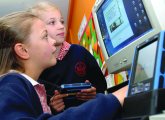Have you lost your maths teaching mojo? Simon Walsh thinks he may have a flipping good solution…
How are maths teachers supposed to inspire and motivate GCSE students if their core objective is to ensure that D/E level students pass an exam with at least a C? Zeb Friedman, an advanced skills maths teacher and the maths subject facilitator for Brighton & Hove’s nine secondary schools, explains this dilemma: “Ofsted and the government seem to be contradicting each other. The government is putting out all sorts of draft proposals about what the maths curriculum should look like, with Ministers espousing the rote learning of facts, whereas Ofsted is very much pushing towards applying problem-solving, real-life maths, making it engaging and fun and relevant.”
“Ofsted doesn’t want us teaching prescriptive stuff from the front,” agrees GCSE maths teacher Andy Lutwyche. “We’re told to aim for a 30/70 balance 30% teacher input, 70% kids doing, discussing, explaining themselves. However, there is no change in the assessment system to truly match this different kind of teaching and learning. The official value of education is still measured by the ability of students to pass exams.”
“We’re in a position where league tables are seen as the be-all and end-all,” says Lutwyche, “with school funding given or taken away according to exam performance. If this wasn’t frustrating enough, teachers are also faced with a stream of negative news about education issues: maths pupils in England are behind those in East Asia; parents are struggling to help their children with maths homework; and the Government plans to increase primary school maths results targets to make pupils more ësecondary readyí, while at the same time proposing curriculum changes that could reduce the uptake of A-level maths.”
Something for everyone
This mixed-message, topline results-above-all environment has made teaching GCSE maths increasingly joyless however, one solution is the kind of flipped teaching approach that is actually being encouraged by Ofsted. It involves teachers focusing on guidance rather than spoon-feeding. Students are taught to find explanations for concepts and do rote learning exercises at their own pace and in their own time outside class, leaving class-time for more mind-expanding, problem-solving activities. In order to achieve this balance and enable them to teach maths in this way, teachers are turning to technology-based tools and materials.
We’ve got to keep experimenting in class, says Friedman, and technology has allowed us to do that, particularly in the last five years or so.
The kind of technology that’s available at secondary school level ranges from simple smartphone apps such as Loughborough University’s mathscard, through advanced calculators, interactive online quizzes, tutorials, puzzles and games, to graphing and modelling software, sophisticated digital multimedia library services like ClickView, and everything in between.
“Technology has made teaching certain maths topics, such as graphs and functions, angles and polygons, a lot easier,” says Lutwyche. “For example I use Maths Doctor TV, a free online video tutorial and worksheet resource for GSCE students. I set the exercises for homework, and I’ve had a lot of really good work back from the kids who find material in this format easy and engaging to use.”
Friedman cites a decisive example of the adoption of technology to support flipped teaching: “A school in Hove has just gone to one device per child and no textbooks, no exercise books – they’re 100 percent online. There’s a lot to be said for this online-only approach in terms of throwing teachers in at the deep end. You have to think about your planning very differently, and you use different apps and engage with completely different software, such as the Explain Everything app as opposed to the smart board software.” Using a flipped teaching approach supported by technology-based aids is not without challenges, including getting the guidance vs spoon-feeding balance right, testing new resources and learning how to use them effectively, and dealing with IT issues. However, it’s worth the benefits it can bring: reigniting your passion for teaching and enabling students to fulfil their potential, as well as meeting the grades demanded by the Government.
“The more inspired I am, the better the pupils at learning and therefore the results,” Lutwyche agrees. “Eventually, it is to be hoped, the Government and exam boards may catch up and change the curriculum and its assessment system to embrace this more holistic approach to teaching and learning for the 21st century.”
ABOUT THE EXPERT
Simon Walsh is a highly experienced maths teacher, and founder and MD of Maths Doctor, the UK’s award-winning digital education company, which provides GCSE and A-level maths teachers, tutors, students and their parents with Maths Doctor TV – a free, online maths video tutorial and interactive worksheet resource.
For a huge selection of free maths lesson plans for KS3 and KS4 click here.










